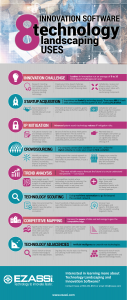In competitive markets where technology is constantly evolving, the ability to identify and understand emerging trends in real-time is an invaluable and essential tool. With Ezassi’s advanced software, technology landscaping and market analysis tools are built-in so that the latest information and access to experts in your field, is right at your fingertips.
— John Naisbitt

By tapping into a larger data set with ease, your organization can more readily source solutions, focus in on more targeted ideas and leverage trending data to make effective decisions moving forward. More data means a more accurate picture of the environment you’re working within, making decisions that have a higher impact.
Learn about the top uses for Technology Landscaping analysis, benefits and functionality. Click below to view and download the infographic.
Effectively pursuing innovation in a fast-paced and competitive market requires a level of global awareness and diligence that is impossible without the help of powerful technology. Ezassi’s tools will allow you to mine big data and take a deep dive into the digital universe to help identify prime targets for innovation and capitalize on opportunities.
Get to know your competition a little better and identify potential trends by taking a closer look at their strengths and weaknesses:
Once you’ve sized up the competition and captured key market data, it’s time to zero in on the most promising technologies for your business. Here’s how to methodically create—and continuously refine—a shortlist that keeps you ahead of the curve:
By following these steps, you’ll move from a broad sweep of options to a refined set of technologies, primed for further investigation and, ultimately, confident selection.
Establishing clear technology requirements is a critical step in any successful innovation process. To ensure the best outcomes, you’ll want to take a structured approach that captures not only your technical needs but also commercial goals and changing market dynamics.
Start by mapping out all must-have features, performance criteria, and compliance considerations. Next, add your commercial requirements—such as budget constraints, time-to-market, regulatory needs, and partnership opportunities. Layer in market-driven priorities by analyzing current trends, customer pain points, and anticipated shifts in demand.
To bring it all together:
This deliberate and data-driven process helps you align technology choices with strategic objectives, ensuring decisions are rooted in both insight and impact.
Once you have a clear grasp of the competitive landscape, it’s time to dig into the specifics of your own requirements. The trick is to compare apples to apples—not apples to flying cars.
Start by outlining what really matters most for your business, whether it’s technical performance, potential for commercial success, regulatory challenges, or integration ease. Assign a level of importance (think weighted scores) to each factor, so your team knows which levers actually move the needle.
Here’s how you can objectively score each technology option:
This systematic approach keeps bias at bay and highlights both clear winners and possible compromises, helping you make informed, transparent choices when selecting your next technology to pursue.
Achieving the best-fit technology solution requires an ongoing process that goes beyond initial identification and comparison. Once you’ve gathered insight into your competitors and scoped out the technological landscape, it’s time to bring design refinement and supplier certainty into the mix.
Here’s how you can seamlessly incorporate these crucial steps:
Integrating these steps ensures that you move forward with a solution that’s not only innovative, but also robust, user-validated, and backed by capable partners. This holistic approach turns your refined shortlist into a strategically selected tech stack—one that can confidently stand up to market demands.
Achieving alignment across a wide range of stakeholders is critical for technology projects to move from concept to reality. Start by creating a collaborative environment where open communication is encouraged; this ensures that ideas, concerns, and aspirations can be shared freely, no matter the department or discipline.
To unify project goals, facilitate workshops or strategy sessions with all key players—think R&D, marketing, legal, and leadership—so that everyone is on the same page from the outset. Use data-driven insights, visual roadmaps, and clear documentation to build a shared vision and highlight how each stakeholder contributes to project success.
Consider leveraging collaborative platforms such as Miro or Microsoft Teams to capture feedback in real-time and keep everyone focused on the same objectives. By integrating these tools with your technology landscaping process, you foster an agile approach where consensus is built organically and efficiently.
With these strategies, your team can overcome silos, build true consensus, and keep the momentum going as you drive your innovation forward.
Technology landscaping tools allow you to track trends over time decide how your company should respond to the market and what your competitors are doing.
Mapping tools mean that you can visualize exactly where innovation is taking place around the world. You can go directly to innovation hotspots and connect with the best experts who can help you drive innovation at your own company. Technology landscaping will help you collaborate with the right people and take advantage of the creative energy of a certain region.
The main dashboard allows you to easily view and digest important information and updates at a glance. The homepage will display:
After narrowing down your options through technology landscaping, the real work of refining your shortlist begins. This stage is all about ensuring that selected technologies truly align with your strategic goals and deliver measurable value.
To move forward with confidence:
By systematically addressing these steps, you set your organization up for a successful implementation—one that’s informed by data, grounded in real user needs, and ready to adapt as the market evolves.